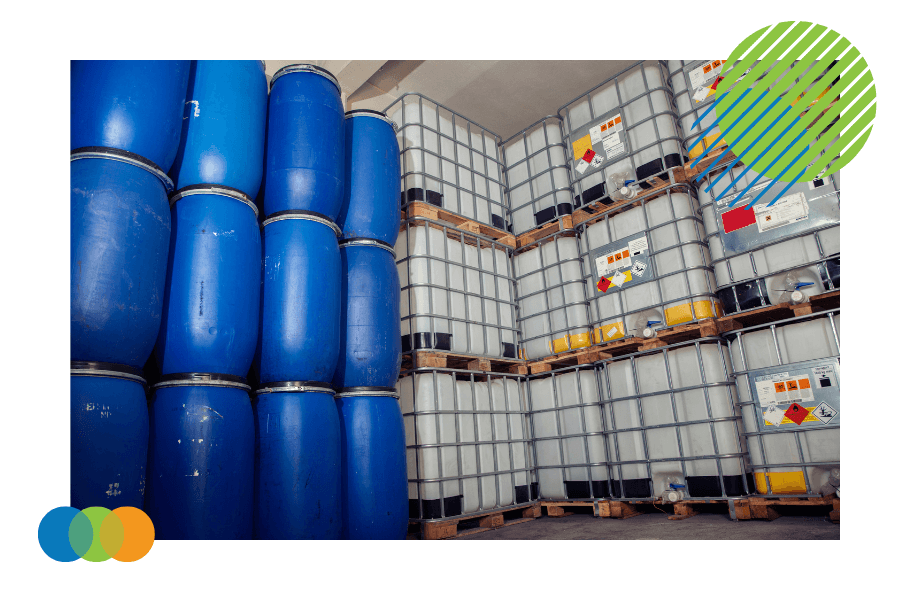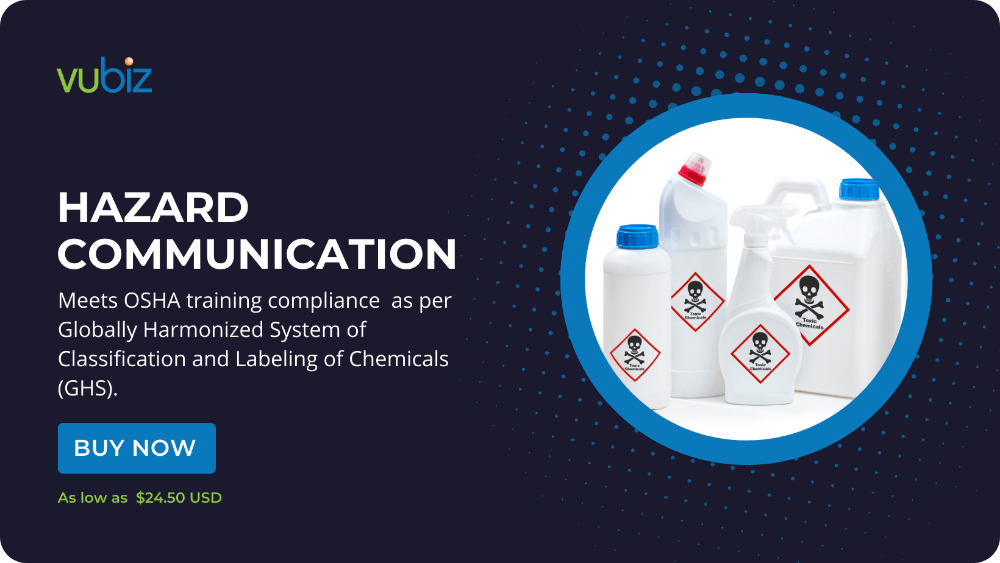 |
Written by Liz McDermott |

Training in Hazard Communication is essential to ensure the security of the workplace, and it is necessary to ensure that the appropriate people are receiving the instruction. Employers who utilize hazardous chemicals in their work environment should begin to make plans to modify their hazard communication education programs, per a mandate from OSHA.
This article explores the components of a successful hazard communication program, including mandatory OSHA's Hazard Communication Standard (HCS) training.
Hazard Communication Program Updates
The Occupational Safety and Health Administration (OSHA) is preparing to renovate its Hazard Communication Standard (HCS) to align with Revision 7 of the United Nations Globally Harmonized System (GHS) of the classification and labeling of chemicals. This update is in accordance with Health Canada, which issued a conclusive decree to modernize its Hazardous Products Regulations (HPR) by January 2023 and resulted in updates to the Workplace Hazardous Materials Information System.
To better protect workers and lower illnesses and injuries caused by chemicals, the accuracy and clarity of labels and safety data sheets (SDSs) for hazardous chemicals are improved. Employers with hazardous chemicals in the workplace should prepare to modify their hazard communication (HazCom) training.
As OSHA states, "The Hazard Communication Standard, implemented in 1983, gave workers the 'right to know,' while the Globally Harmonized System has granted them the 'right to understand."

What is HazCom Training?
The Hazard Communication Training aims to ensure that individuals understand the risks associated with hazardous materials.
To guarantee safety concerning hazardous substances in the workplace, OSHA created the Hazard Communication Standard. This standard educates personnel about the threats associated with the chemicals they are dealing with and how to limit potential exposure. Additionally, the HCS requires employers to offer their staff comprehensive HazCom training to reduce the possibility of injuries or illnesses from chemical hazards.
Giving employees HazCom instruction enables them to interpret and comprehend the risk details provided on labels and SDSs for the chemicals they have contact with and how to put this into practice in the work environment.
OSHA HCS proclaims that everyone in the workplace who works with hazardous materials or may come into contact with them must receive training. The agency states that the requirements for the training are comprehensive in scope and that it applies to any situation in which a chemical is present and could cause exposure to employees during regular usage or in an unanticipated situation.
Need help training workers on hazardous chemicals and safety data sheets?
When selecting Hazard Communication training, it is best to consider an interactive format that engages employees. This way, they will better understand the materials and be more likely to stay attentive during the training.
Vubiz's comprehensive safety training library includes an OSHA Hazard Communication training course. Compliment your written Hazard Communication program today with this interactive training solution.
The Cost of Violating Training Regulations Related to Hazardous Chemicals
Employers should comply with OSHA regulations to avoid hefty fines and legal repercussions by ensuring employees receive the proper training on hazardous chemicals. According to OSHA's Top 10 List of Most Frequently Cited Standards, HazCom violations were the second-most common workplace violations in 2022. These violations can incur fines of up to $15,625 per violation per day, as well as potential criminal charges and civil lawsuits.
Poor HazCom training is frequently the cause of these violations. It can lead to decreased profitability due to fines or a loss of revenue due to employees being unable to work because of chemical exposure.
Who Needs OSHA's Hazard Communication Standard Training?
It is essential to be familiar with the operations, job tasks, chemicals used, and potential exposure routes to ascertain which staff members need training. At a minimum, evaluate and verify the training of all new employees, employees who have been transferred, and any temporary staff members or contractors.
OSHA's recent Temporary Worker Initiative has made it clear that both staffing agencies and employers share the responsibility for the safety of temporary workers. The agencies should ensure that their personnel is adequately educated on the general HazCom requirements and the potential dangers associated with the chemicals they might come into contact with in multiple workplaces.
On the other hand, contracting employers must provide training on the specific hazards present in their facilities. For this purpose, communication between the staffing agency and the contractor provider must be established to avoid any kind of training gaps.
7 Steps for Effective Hazard Communication Programs
A solid hazard communication training plan can be developed by utilizing the following steps:
- Identifying potential risks
- Establishing a system of communication
- Expanding a definition of what constitutes a hazard
- Creating a procedure for informing employees of potential hazards
- Establishing a protocol for reporting hazardous incidents
- Crafting a training program to teach employees safety practices
- Develop a system to monitor compliance

Components of a Hazard Communication Training Program
Besides determining who needs training, following OSHA's Hazard Communication Standard calls for a comprehensive written hazard communication program. OSHA has a Model Training Program to reference. However, reviewing the regulatory requirements in OSHA's 29 CFR 1910.1200(h)(3) is always prudent.
The Hazard Communication Standard indicates that HazCom training must, at minimum, encompass the following:
- Employers must monitor the work area with various methods and observations to uncover physical and health hazards related to the presence or release of a hazardous chemical, such as conducting regular safety audits to identify visual cues and odors and implementing continuous monitoring devices.
- Workers must be aware of the physical and chemical properties related to chemical hazards like simple asphyxiation, combustible dust, and pyrophoric gas hazards—as well as any other hazard warnings not otherwise classified—of the hazardous chemicals in the work area.
- Workers should take the necessary steps to ensure chemical safety and protect themselves from health and physical hazards, including following the company's hazardous chemical procedures and engineering controls for exposure protection, accidental release measures, proper chemical labeling, appropriate protective measures, disposal considerations, the use of personal protective equipment (PPE), first aid measures and emergency procedures.
- The employer's hazard communication written program should inform employees in detail, including explaining the labels received on shipped containers from chemical manufacturers and importers and the workplace labeling system for hazardous chemicals.
- Employers must provide safety data sheets and how employees can access them and educate workers on the order of information on a safety data sheet and how to use the appropriate hazard information, such as hazard statements, signal words, and pictograms.
What level of comprehension is OSHA anticipating from employees?
According to OSHA's HazCom Handbook for Small Businesses, the goal of employee training is for workers to grasp the idea that they are being exposed to hazardous chemicals, know how to read and interpret hazard information on labels found on chemical containers including the meaning of hazardous chemical symbols, the precautionary statement and hazard statement in safety data sheets, and know how to access this information – even in the event of a power failure.
OSHA requires that employee training be provided in a way they can comprehend. Employers must train workers by first educating them about the hazardous chemicals they come in contact with or the hazard classes and categories of such compounds.
When should training take place?
Training should occur before beginning work with these substances when new hazards are introduced to the workplace, when changes are made to the HazCom system, replacing physical safety sheet binders with electronic formats, for example, or when there is evidence that the training wasn't unsuccessful.
In Summary: Investing in Hazard Communication Training Pays Off
HazCom training guarantees that personnel, temporary workers, and contractors possess the information they need to keep themselves safe from exposure to dangerous chemicals they work with. When training is executed appropriately, it promotes a safety culture of transparency and open communication between workers and employers.
Setting measurable goals with performance conditions ensures a successful training program. These conditions can be demonstrated in test results so that it can be seen that the learning objectives have been achieved.
For a deeper dive into HazCom training regulations, Appendix B in OSHA's Small Entity Compliance Guide for Employers That Use Hazardous Chemicals is a helpful resource.
For more information, please contact us to inquire about our Health & Safety training programs.

